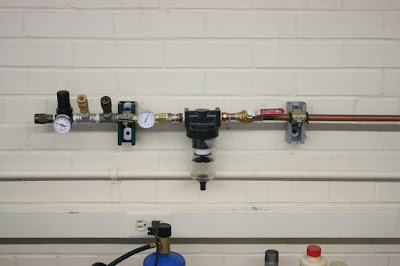 This post brings us back from the surreal world of The Wizard of Oz to the surreal world of vertebrate paleontology. I'm finally following up on a post-SVP promise to chronicle the tour of the Paleontological Conservation Unit at The Natural History Museum in London. The day began standing around the front gates until a helpful fellow attendee who read the directions (Greg Brown) pointed out that we should be using the side entrance for staff and visitors. Thanks Greg.
This post brings us back from the surreal world of The Wizard of Oz to the surreal world of vertebrate paleontology. I'm finally following up on a post-SVP promise to chronicle the tour of the Paleontological Conservation Unit at The Natural History Museum in London. The day began standing around the front gates until a helpful fellow attendee who read the directions (Greg Brown) pointed out that we should be using the side entrance for staff and visitors. Thanks Greg.
I think it would be fair to describe the PCU facility as cavernous. Despite my best efforts I couldn't capture more than, say, 26.2% of the lab in any particular photo. The first one is looking towards the corner where fossil preparation takes place. I've long been interested by the PCU as laid out on their website (links are all dead thanks to a remodel), which defines all aspects of working with specimens based on the corresponding roles within the fields of conservation and preparation. In principle this sounds really great, but after seeing the operation more or less in practice (at least in demonstration) I've begun to rethink some of my preparation philosophy. That topic probably strays too far afield for this post, so we'll get back to the tour already in progress.

PCU Fossil Preparator Scott Moore-Fay holding up a specimen that he is working on, that may have been a trilobite, time is the enemy of my memory. He has a very nice Leica stereo microscope mounted on an articulating arm, and a helpful bellows-adjusting head. There is a ring-light mounted on the objective, good lighting around the workstation, ceiling mounted exhaust, and a plethora of overhead electrical outlets that I like to have everywhere to eliminate extension cords.

Scott's workstation, I also like the table top flammable cabinet. Good chair.

Ooooooo....ahhhhh....

We are going to leave the main lab briefly and step down a corridor to the acid preparation lab. Holy smokes, another whole lab for acid preparation? Yup. In this photo you are seeing a little over half of it. Look at these great, ventilated acid baths. Acid can be fed into them from an outdoor storage tank that might be around 300L, though I may be wrong on quantity. I also recall that this lab uses acetic acid almost exclusively, but that can also be corrected by those more knowledgeable. I'm going to break this post here so I can get some other things done, and will follow up with the rest of the tour, finish off in the acid lab, and discuss the conservation aspects of the PCU. This might also be a good place to point out that Scott is the only full time staff preparator at the Natural History Museum. Amazing, I know. For those who haven't worked in an institution this size, it can be tough to wrap your mind around the fact that there could be something in the neighborhood of 1000 years or more of backlog preparation in the collections alone, which seems like it represent great job security for that lucky dude or dudette.












































